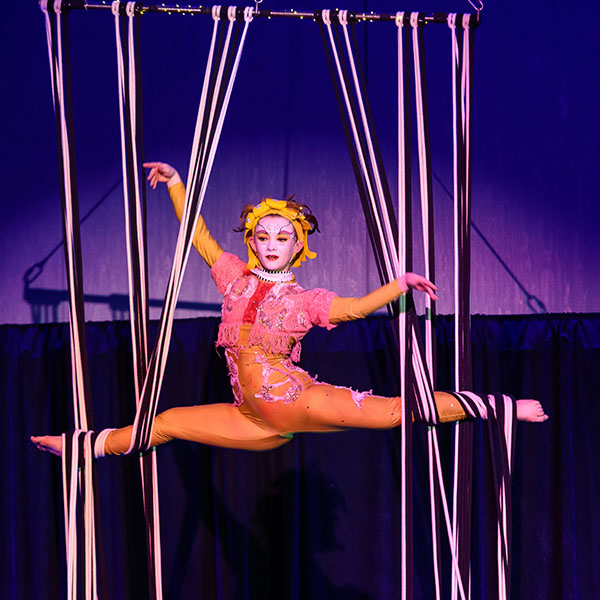At this year’s meeting in Las Vegas, circus performers embodied mind-boggling quantum concepts on the stage.
By Sophia Chen | April 13, 2023

Credit: APS Physics
The Le Petit Cirque troupe’s physics-themed performance at the March Meeting.
The APS March Meeting 2023 took place in star-studded Las Vegas, complete with an Albert Einstein impersonator (an APS hire with a pan-European accent) and 2022 Nobel Laureates John Clauser and Anton Zeilinger (they regaled an audience with quantum mechanics).
But the most eminent celebrity to make an appearance? Schrödinger’s cat.
The famous feline made an appearance in an APS-commissioned circus act titled “Cosmic Tumbles and Quantum Leaps” that kicked off the meeting on Sunday, March 5, in Caesar’s Forum, the conference venue. In a half-hour program, acrobats and contortionists leapt, spun, and threw each other in the air in choreography inspired by physics concepts. Nathalie Yves Gaulthier, who directed the performance, described the program as “Cirque du Soleil meets Lion King meets quantum physics.”
The performers were part of Le Petit Cirque, a Los-Angeles based youth circus troupe whose ages ranged from 9 to 16. They train between 20 and 30 hours a week, said Gaulthier, while also attending school, sometimes through homeschooling when they have to travel. “Even on this trip, they are being monitored by a labor board-certified studio teacher,” said Gaulthier.
The group calls themselves a “Youth Humanitarian Circus,” as their performances often raise money for important causes, including for people injured in land mines. The group performed at the 2017 Nobel Peace Prize concert in Oslo, Norway, as well as the Dalai Lama’s 80th birthday at the University of California, Irvine. “Our next goal is the pope,” said Nathalie Yves Gaulthier, the director of the troupe, before the show. The audience chuckled. “Not joking. I’m not kidding,” she said.
“People asked me, ‘Are you going to encourage our physicists to gamble?’” said Smitha Vishveshwara of the University of Illinois, Urbana-Champaign, who, as program chair of the meeting, helped produce the performance. “No. Las Vegas has an amazing performance scene. ‘That’s what we’re going to tap into,’ I said.”
Vishveshwara had read in APS News about a physicist, Julia Ruth, who had left a graduate school program in geophysics at Scripps Institute of Oceanography to become a full-time circus performer. Last August, Vishveshwara and other meeting organizers emailed Ruth to ask if she could help them produce a circus act for the meeting.
“They sent me a really long email, and I didn’t read it right away because it said ‘Dear Dr. Ruth,’” said Ruth. “Usually when someone sends that, they think I finished my PhD because of my publications from forever ago, and they want me to subscribe to something.”
Fortunately for Vishveshwara, Ruth still read the message. “I was like, ‘Yes. This has to happen. I have to be a part of this,’” said Ruth. She connected the APS meeting organizers with Le Petit Cirque, which Ruth used to coach for. Gaulthier, who founded the troupe, jumped at the opportunity. Gaulthier, Ruth, and Vishveshwara met over Zoom several times to plan.
The performance featured numbers such as “Emergence,” with acrobats leaping and tumbling in formation with glowing LED lights, and “Entanglement,” where an aerialist climbed high into the air on rippling ribbons attached to a trapeze hung from the ceiling. Schrödinger’s cat, a contortionist in leopard print, with a tail and ears, started her number trapped in a Plexiglas box with her spine bent in a U shape. She leapt in and out of the box as another performer peered at her through sequined binoculars, the “observer” of the quantum system. The cat toggled between being “awake” and “asleep” in response to the observer, in analogy to Schrödinger’s quantum thought experiment. Vishveshwara penned a dramatic voiceover that described the physics behind the performance, which Gaulthier recorded and played for the performance in Las Vegas.

Credit: APS Physics
A young performer of Le Petit Cirque.
“It’s just freeing,” Bixby Baker, 13, one of the performers, told APS News. “When you’re performing, it feels like there’s nothing else in the world.”
The production required careful planning, as the troupe dangled spinning structures and trapezes from the ceiling that the acrobats performed within. “A lot of times you work with people, and it’s like, ‘hello? Can we discuss where you’re putting those trapezes?’ said Gaulthier. “It was really pleasant and refreshing to work with physicists because everyone had a brain. We got to move forward so much more quickly.”
Although they were depicting quantum phenomena, the troupe offered a dazzling demonstration of classical physics. As they spun and leaped, each performer had an intuitive mastery of gravity and angular momentum beyond any physics homework problem. “Even though [circus] is a visual representation of physics, I think it also appears to defy physics in some ways, because we're challenging what the human body can do,” said Ruth.
“You know when you win something, you get that rush of excitement, and you’re like, ‘Oh my gosh, I just did that’?” said Lyra Gross, 16, one of the performers. “It's like that, combined with the feeling you get when you help a friend, because you’re giving something to the audience.”
The circus act was a reminder that physics is everything around us — including our own bodies. It can be easy to lose sight of that during the March Meeting, as physics seems relegated to 12-minute PowerPoint presentations. But meeting participants self-assemble into neat rows; tourists condense into their basest state in front of slot machines in smoke-filled casino lobbies. Physicists are not merely observers of nature, but participants too.
Sophia Chen is a writer based in Columbus, Ohio.
©1995 - 2024, AMERICAN PHYSICAL SOCIETY
APS encourages the redistribution of the materials included in this newspaper provided that attribution to the source is noted and the materials are not truncated or changed.
Editor: Taryn MacKinney
May 2023 (Volume 32, Number 5)
Articles in this Issue

